Shanle Yao
ALFred: An Active Learning Framework for Real-world Semi-supervised Anomaly Detection with Adaptive Thresholds
Aug 12, 2025Abstract:Video Anomaly Detection (VAD) can play a key role in spotting unusual activities in video footage. VAD is difficult to use in real-world settings due to the dynamic nature of human actions, environmental variations, and domain shifts. Traditional evaluation metrics often prove inadequate for such scenarios, as they rely on static assumptions and fall short of identifying a threshold that distinguishes normal from anomalous behavior in dynamic settings. To address this, we introduce an active learning framework tailored for VAD, designed for adapting to the ever-changing real-world conditions. Our approach leverages active learning to continuously select the most informative data points for labeling, thereby enhancing model adaptability. A critical innovation is the incorporation of a human-in-the-loop mechanism, which enables the identification of actual normal and anomalous instances from pseudo-labeling results generated by AI. This collected data allows the framework to define an adaptive threshold tailored to different environments, ensuring that the system remains effective as the definition of 'normal' shifts across various settings. Implemented within a lab-based framework that simulates real-world conditions, our approach allows rigorous testing and refinement of VAD algorithms with a new metric. Experimental results show that our method achieves an EBI (Error Balance Index) of 68.91 for Q3 in real-world simulated scenarios, demonstrating its practical effectiveness and significantly enhancing the applicability of VAD in dynamic environments.
Exploring Pose-Based Anomaly Detection for Retail Security: A Real-World Shoplifting Dataset and Benchmark
Jan 11, 2025Abstract:Shoplifting poses a significant challenge for retailers, resulting in billions of dollars in annual losses. Traditional security measures often fall short, highlighting the need for intelligent solutions capable of detecting shoplifting behaviors in real time. This paper frames shoplifting detection as an anomaly detection problem, focusing on the identification of deviations from typical shopping patterns. We introduce PoseLift, a privacy-preserving dataset specifically designed for shoplifting detection, addressing challenges such as data scarcity, privacy concerns, and model biases. PoseLift is built in collaboration with a retail store and contains anonymized human pose data from real-world scenarios. By preserving essential behavioral information while anonymizing identities, PoseLift balances privacy and utility. We benchmark state-of-the-art pose-based anomaly detection models on this dataset, evaluating performance using a comprehensive set of metrics. Our results demonstrate that pose-based approaches achieve high detection accuracy while effectively addressing privacy and bias concerns inherent in traditional methods. As one of the first datasets capturing real-world shoplifting behaviors, PoseLift offers researchers a valuable tool to advance computer vision ethically and will be publicly available to foster innovation and collaboration. The dataset is available at https://github.com/TeCSAR-UNCC/PoseLift.
PHEVA: A Privacy-preserving Human-centric Video Anomaly Detection Dataset
Aug 26, 2024Abstract:PHEVA, a Privacy-preserving Human-centric Ethical Video Anomaly detection dataset. By removing pixel information and providing only de-identified human annotations, PHEVA safeguards personally identifiable information. The dataset includes seven indoor/outdoor scenes, featuring one novel, context-specific camera, and offers over 5x the pose-annotated frames compared to the largest previous dataset. This study benchmarks state-of-the-art methods on PHEVA using a comprehensive set of metrics, including the 10% Error Rate (10ER), a metric used for anomaly detection for the first time providing insights relevant to real-world deployment. As the first of its kind, PHEVA bridges the gap between conventional training and real-world deployment by introducing continual learning benchmarks, with models outperforming traditional methods in 82.14% of cases. The dataset is publicly available at https://github.com/TeCSAR-UNCC/PHEVA.git.
Evaluating the Effectiveness of Video Anomaly Detection in the Wild: Online Learning and Inference for Real-world Deployment
Apr 29, 2024Abstract:Video Anomaly Detection (VAD) identifies unusual activities in video streams, a key technology with broad applications ranging from surveillance to healthcare. Tackling VAD in real-life settings poses significant challenges due to the dynamic nature of human actions, environmental variations, and domain shifts. Many research initiatives neglect these complexities, often concentrating on traditional testing methods that fail to account for performance on unseen datasets, creating a gap between theoretical models and their real-world utility. Online learning is a potential strategy to mitigate this issue by allowing models to adapt to new information continuously. This paper assesses how well current VAD algorithms can adjust to real-life conditions through an online learning framework, particularly those based on pose analysis, for their efficiency and privacy advantages. Our proposed framework enables continuous model updates with streaming data from novel environments, thus mirroring actual world challenges and evaluating the models' ability to adapt in real-time while maintaining accuracy. We investigate three state-of-the-art models in this setting, focusing on their adaptability across different domains. Our findings indicate that, even under the most challenging conditions, our online learning approach allows a model to preserve 89.39% of its original effectiveness compared to its offline-trained counterpart in a specific target domain.
Integrating AI into CCTV Systems: A Comprehensive Evaluation of Smart Video Surveillance in Community Space
Dec 04, 2023
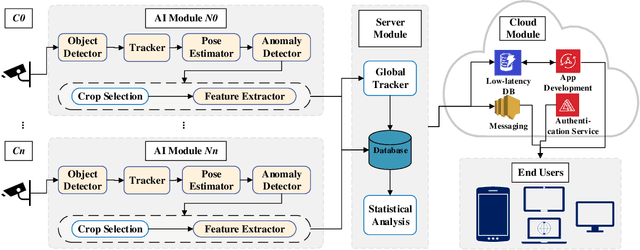
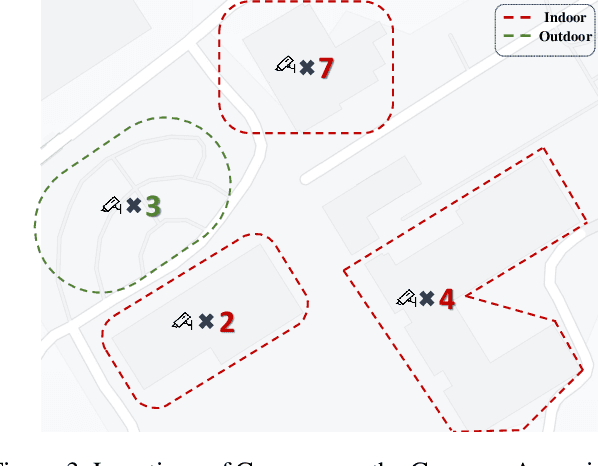
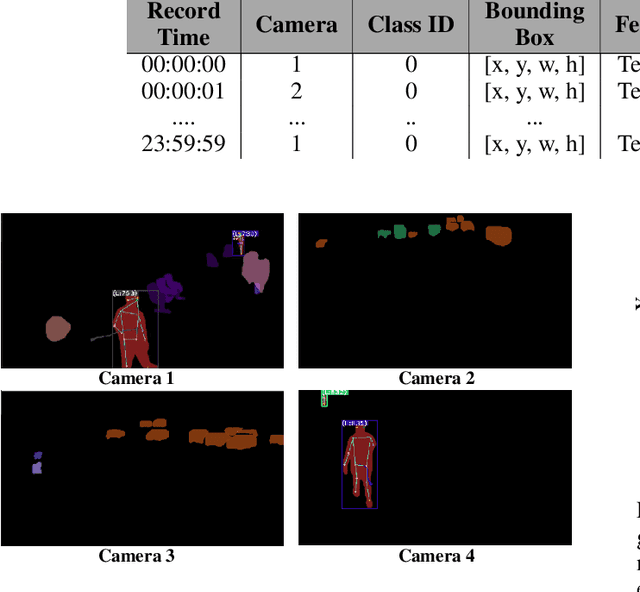
Abstract:This article presents an AI-enabled Smart Video Surveillance (SVS) designed to enhance safety in community spaces such as educational and recreational areas, and small businesses. The proposed system innovatively integrates with existing CCTV and wired camera networks, simplifying its adoption across various community cases to leverage recent AI advancements. Our SVS system, focusing on privacy, uses metadata instead of pixel data for activity recognition, aligning with ethical standards. It features cloud-based infrastructure and a mobile app for real-time, privacy-conscious alerts in communities. This article notably pioneers a comprehensive real-world evaluation of the SVS system, covering AI-driven visual processing, statistical analysis, database management, cloud communication, and user notifications. It's also the first to assess an end-to-end anomaly detection system's performance, vital for identifying potential public safety incidents. For our evaluation, we implemented the system in a community college, serving as an ideal model to exemplify the proposed system's capabilities. Our findings in this setting demonstrate the system's robustness, with throughput, latency, and scalability effectively managing 16 CCTV cameras. The system maintained a consistent 16.5 frames per second (FPS) over a 21-hour operation. The average end-to-end latency for detecting behavioral anomalies and alerting users was 26.76 seconds.
Real-World Community-in-the-Loop Smart Video Surveillance -- A Case Study at a Community College
Mar 22, 2023
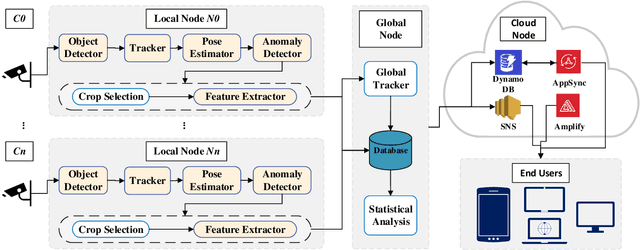

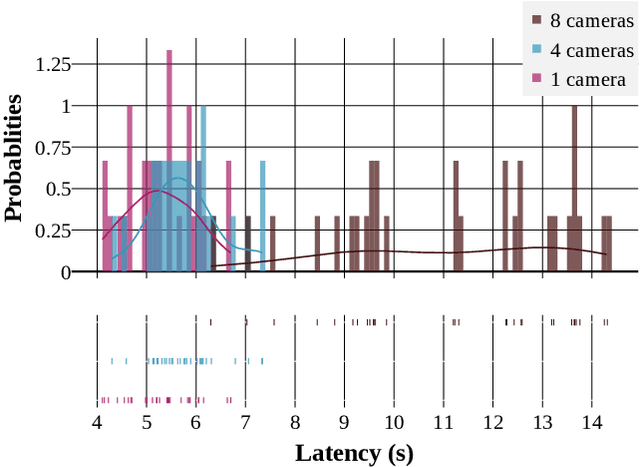
Abstract:Smart Video surveillance systems have become important recently for ensuring public safety and security, especially in smart cities. However, applying real-time artificial intelligence technologies combined with low-latency notification and alarming has made deploying these systems quite challenging. This paper presents a case study for designing and deploying smart video surveillance systems based on a real-world testbed at a community college. We primarily focus on a smart camera-based system that can identify suspicious/abnormal activities and alert the stakeholders and residents immediately. The paper highlights and addresses different algorithmic and system design challenges to guarantee real-time high-accuracy video analytics processing in the testbed. It also presents an example of cloud system infrastructure and a mobile application for real-time notification to keep students, faculty/staff, and responsible security personnel in the loop. At the same time, it covers the design decision to maintain communities' privacy and ethical requirements as well as hardware configuration and setups. We evaluate the system's performance using throughput and end-to-end latency. The experiment results show that, on average, our system's end-to-end latency to notify the end users in case of detecting suspicious objects is 5.3, 5.78, and 11.11 seconds when running 1, 4, and 8 cameras, respectively. On the other hand, in case of detecting anomalous behaviors, the system could notify the end users with 7.3, 7.63, and 20.78 seconds average latency. These results demonstrate that the system effectively detects and notifies abnormal behaviors and suspicious objects to the end users within a reasonable period. The system can run eight cameras simultaneously at a 32.41 Frame Per Second (FPS) rate.
Ancilia: Scalable Intelligent Video Surveillance for the Artificial Intelligence of Things
Jan 09, 2023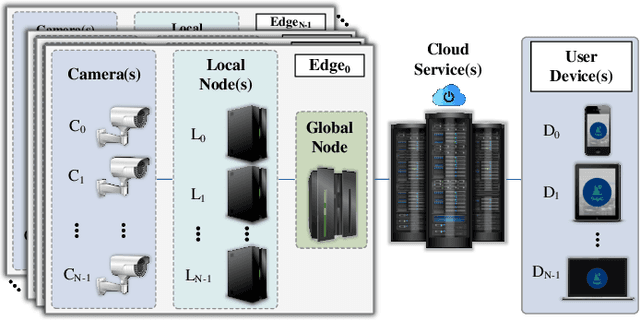
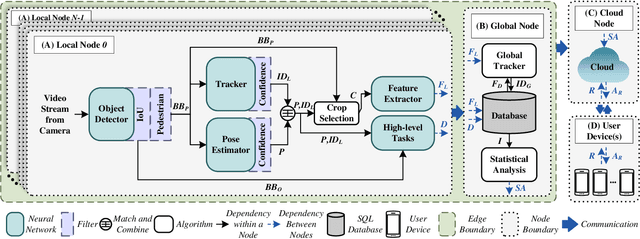
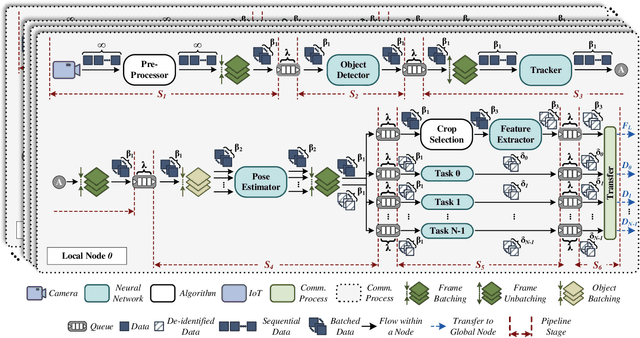

Abstract:With the advancement of vision-based artificial intelligence, the proliferation of the Internet of Things connected cameras, and the increasing societal need for rapid and equitable security, the demand for accurate real-time intelligent surveillance has never been higher. This article presents Ancilia, an end-to-end scalable, intelligent video surveillance system for the Artificial Intelligence of Things. Ancilia brings state-of-the-art artificial intelligence to real-world surveillance applications while respecting ethical concerns and performing high-level cognitive tasks in real-time. Ancilia aims to revolutionize the surveillance landscape, to bring more effective, intelligent, and equitable security to the field, resulting in safer and more secure communities without requiring people to compromise their right to privacy.
 Add to Chrome
Add to Chrome Add to Firefox
Add to Firefox Add to Edge
Add to Edge